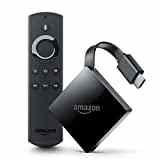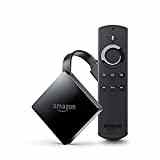The Amazon Fire TV with 4K Ultra HD isn’t the company’s first foray into the world of better-than-HD resolution TV streamers. In fact, the company’s Fire TV 4K box was one of the first you could buy back in 2015. Apple and Google lagged behind and so did Roku (at least here in the UK).
The paucity of 4K content at the time ensured it wasn’t the rip-roaring success it might have been, though, and slowly but surely Amazon’s rivals have caught up and overtaken the retail giant, offering products with HDR, which the original didn’t have.




Amazon Fire TV with 4K Ultra HD (2017) review: What you need to know
The “all-new” Amazon Fire TV 4K is quite a departure from Amazon’s first 4K streamer. This time, instead of adopting a set-top box type design, it’s a dongle, just like regular Fire TV stick. And, just like all Fire TV products, it can be used to watch everything from Netflix to BBC and Amazon Prime Video content and even stream music and radio.
Although it looks different, the only real difference between this and the standard Fire TV stick is that it supports 4K resolution, HDR10 and Dolby Atmos audio; you’ll need a compatible soundbar or surround-sound speaker setup to make the most of the latter, though. It also comes supplied with an Alexa voice remote, which allows you to search and control playback with your voice, among other things.
READ NEXT: Amazon Fire TV Stick (2017) review
Amazon Fire TV with 4K Ultra HD (2017) review: Price and competition
The first thing to be aware of is that the new Fire TV is considerably more expensive than the regular Fire TV Stick. It’s £70 where the Stick is £40, but that’s par for the course when it comes to 4K streamers.
The Chromecast Ultra, for instance, which also offers 4K compatibility, costs £69 while the recently announced Roku Streaming Stick+ – another 4K streamer – will set you back £80. Its other main competitor is the Apple TV 4K but that’s in another league, price-wise, at £179.
Amazon Fire TV with 4K Ultra HD (2017) review: Design and features
Physically, there isn’t a huge amount to say about the new Fire TV. It’s a lot smaller and more discreet than the original 4K Fire TV, but it’s also bulkier and than the standard Stick. It’s flat and square (or diamond-shaped depending on which way you look at it), and connects to your TV via a flat, stubby HDMI cable emerging from one corner. It’s powered via a micro-USB connection set into the opposite corner.
Amazon recommends you use the supplied mains adapter to power the Fire TV but, depending on your TV, you might be able to get away with simply plugging it into a spare USB socket. Either way, setup is pretty straightforward and the Fire TV 4K will tell you if your TV’s USB ports are supplying enough power to run in 4K anyway.
Like the Fire TV Stick, and unlike its rival the Chromecast Ultra, the Fire TV 4K comes with a remote control and this works brilliantly. It’s slim, light, fits in the hand neatly and isn’t overburdened with buttons. It connects via Bluetooth so you don’t have to point it at the TV to get it to work and it comes with Alexa compatibility. Basically, you can speak to it much in the same way as you can an Amazon Echo or Echo Dot.
As before, though, you don’t have to use the remote if you don’t want to. The Fire TV 4K can also be controlled via the free smartphone app, which works across iOS, Android and Fire OS devices.
The big changes, however, are inside and here there’s support for 4K and HDR10 content at up to 60fps. There’s an improved 1.5GHz quad-core Amlogic S905Z processor backed by 2GB of RAM and 8GB of storage for installing games and apps.
Wireless connectivity, incidentally, is delivered by dual-band 802.11ac Wi-Fi and the device also has dual-antenna 2x2 MIMO. If nothing else, this should ensure the Fire TV 4K is able to hold a stronger connection, although it is possible to hook up the stick via Ethernet using the optional £14 adapter if you’re having difficulty getting a reliable connection.
Amazon Fire TV with 4K Ultra HD (2017): Content and usability
Just like the regular Fire TV stick, there’s plenty of content to get your teeth into. The big streaming video services are in place, including Netflix, BBC iPlayer, ITV Hub, All 4 and My5 – with the added bonus of Amazon Video, of course, which delivers plenty of 4K content.
As far as music goes, there’s plenty of coverage there, too. There’s Amazon Music, of course, and support for Spotify and TuneIn Radio. If you stream from a NAS or shared drive you can install Plex.
As ever, there are one or two big names missing from this list. Most notable, for UK users at least, is Sky’s streaming service Now TV, but there’s also no Tidal for music fans. It is possible to fill in the gaps by sideloading, but that’s a faff I’d rather not have to go through. If Now TV is important to you, the Roku Streaming Stick+ is a better option as it has wider coverage, including Sky’s streaming service.
Largely speaking, though, there’s plenty of content on the Fire TV 4K and it all looks absolutely stunning. In fact, compared with the integrated apps on the Hisense TV I tested it on, I found the picture quality much cleaner and clearer and the UI far more responsive and easy to get around.
In keeping with the redesign accompanying last year’s Fire Stick refresh, the Fire TV stick is now more Netflix-like, with a featured item filling much of the upper portion of the display and category carousels lined up horizontally below.
The Alexa-based functions, accessed via the bundled voice remote, work beautifully. Hold down the microphone function on the remote and you can search across multiple services for TV and movie titles from the homescreen.
It’s also possible to play, pause and skip to specific positions in the programme you’re watching and you also can access most of Alexa’s other functions, including as smart home integrations. If you have, say, some Philips Hue lightbulbs, or a Hive or Nest smart thermostat, you can control it via the Fire TV’s voice remote in exactly the same way as via an Amazon Echo.
I say “most” because, oddly, the Fire TV 4K can’t use Alexa’s super-useful Drop In function on the Fire TV to call Echo and Echo Dot speakers, a feature that would be useful in my Echo-festooned house.
Amazon Fire TV 4K HDR: Verdict
It’s taken its precious time about it, but the new Fire TV 4K is finally here and it works very well indeed. The Alexa facilities, in particular, are great to have and make finding content across multiple services incredibly easy.
Compared with the Chromecast Ultra, there isn’t much to choose, but I prefer using the Fire TV simply because it has a dedicated remote and you don’t need to shell £50 extra on a Google Home Mini to enable voice facilities.
Whether it’s a sensible purchase for you, though, depends on your circumstances. If you have a 4K TV like mine whose “smart” facilities leave much to be desired and you already pay for Amazon Prime or already own an Echo or Echo Dot, then I wouldn’t hesitate to recommend it. It’s a slick, easy-to-use streamer with very few flaws.
If you own Google Home or Chromecast audio, I’d recommend the Chromecast Ultra instead, and if Sky Now is a priority, then the Roku Streaming Stick+ makes more sense, but as an all-rounder, even considering its limitations, the Amazon Fire TV with 4K is currently the best 4K streaming stick on the market.
